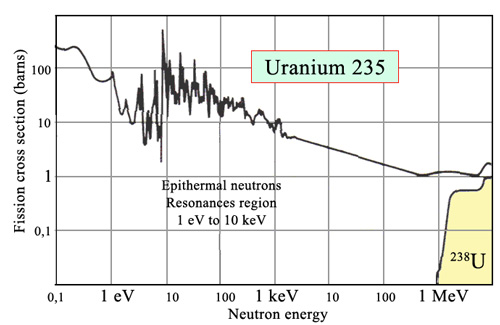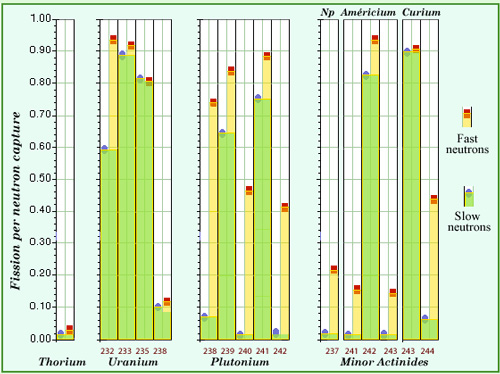Fast neutrons for surgeneration and breeders
Before they are slowed down by a large number of nuclear collisions, neutrons produced by fission reactions are considered fast. They usually have energies between 0.1 and 2 or 3 MeV.
The fact that they possess a substantial amount of kinetic energy allows fast neutrons to fission more nuclei once they get captured. They can therefore split not only nuclei reputed fissile by slow neutrons, but also minor actinides, the heavy nuclei which build up inside nuclear fuel as radioactive waste. Fast neutrons are needed to eliminate these waste products.

Fission probability of uranium-235 with neutron energy
The fission probability of uranium-235 nuclei by fast neutrons whose energy is large compared to that of slow neutrons (called « thermal ») is only of a few barns compared to 584 barns for thermal neutrons of 0.025 eV. To compensate, reactors using these neutrons require nuclear fuel rich in fissile material and high neutron flux.
© IN2P3
The use of fast neutrons in ‘fast reactors’ allows for the production of more fissile nuclei than are destroyed, as the absorption of at least one neutron per fission by an uranium 238 nucleus transforms this uranium 238 into a fissile plutonium 239 nucleus. This process is known as breeding, leading as it does to an almost inexhaustible supply of fuel.
The drawback of fast neutrons in reactors is that the probabilities of their capture by nuclei are comparatively small. Travelling in matter, neutrons see nuclei as targets. The apparent cross-section of these targets is much more smaller for fast neutrons than it is for slow neutrons. As a result, an intense neutron flux and a fuel rich in fissile elements are both needed to compensate for this lower probability.

Avantage to fast neutrons
The surplus of energy carried by fast neutons favors fission of fragile heavy nuclei. Fast neutrons are able to fission all heavy nuclei present in the reactors including those considered non fissile by slow neutrons. The figure compares the percentages of neutron captures followed by fission for the main isotopes of uranium, plutonium and minor actinides in the cases of the slow neutrons of a conventional pressurized water reactor (PWR) and those of an hybrid reactor where they are or very fast.
© IN2P3
Fast neutron reactors have been in operation, but in 2012 they can be counted on the fingers of a single hand. SUPERPHÉNIX in France has been the only major reactor of this type to have been operating. It was shut down in 1997 for political rather than technical reasons. However, most of the concepts of generation IV reactors planned by 2040 would be fast breeder reactors. France was embarked, with a project – a demonstrator – called ASTRID.
As has been said above, fast reactors would be able to burn, among heavy nuclei, minor actinides – which constitute radioactive waste that are very long-lived – and thus would contribute to reduce their inventory.
There are also projects of reactors coupled to an accelerator (Accelerator Driven System or ADS) llke the European MHYRRA project. These « waste burners‘ would be dedicated to the destruction of minor minor actinides with neutrons that could be said very fast. The energy of the neutrons available in hybrid reactors would be of several MeV, well above the energy of fission neutrons.
ALSO : Slow neutrons
ALSO : Neutron capture
Other articles on the subject « Neutronic Radiations »
Neutron Capture
Capture competes with fission and generates radioactivity The neutron is a special elementary par[...]
Neutron Balance (fission)
What happens to fission neutrons? Within a reactor the objective is to maintain the chain reactio[...]
Slow and fast neutrons
Fission depends on the energy of the neutrons Nuclear fission can occur when a nucleus is rendere[...]
Slow neutrons
Slow neutrons favour fission In nuclear reactors slow neutrons are neutrons slowed down after a s[...]
Neutron Moderators
Slowing fast neutrons without capturing them The presence of a moderator; is essential for operat[...]